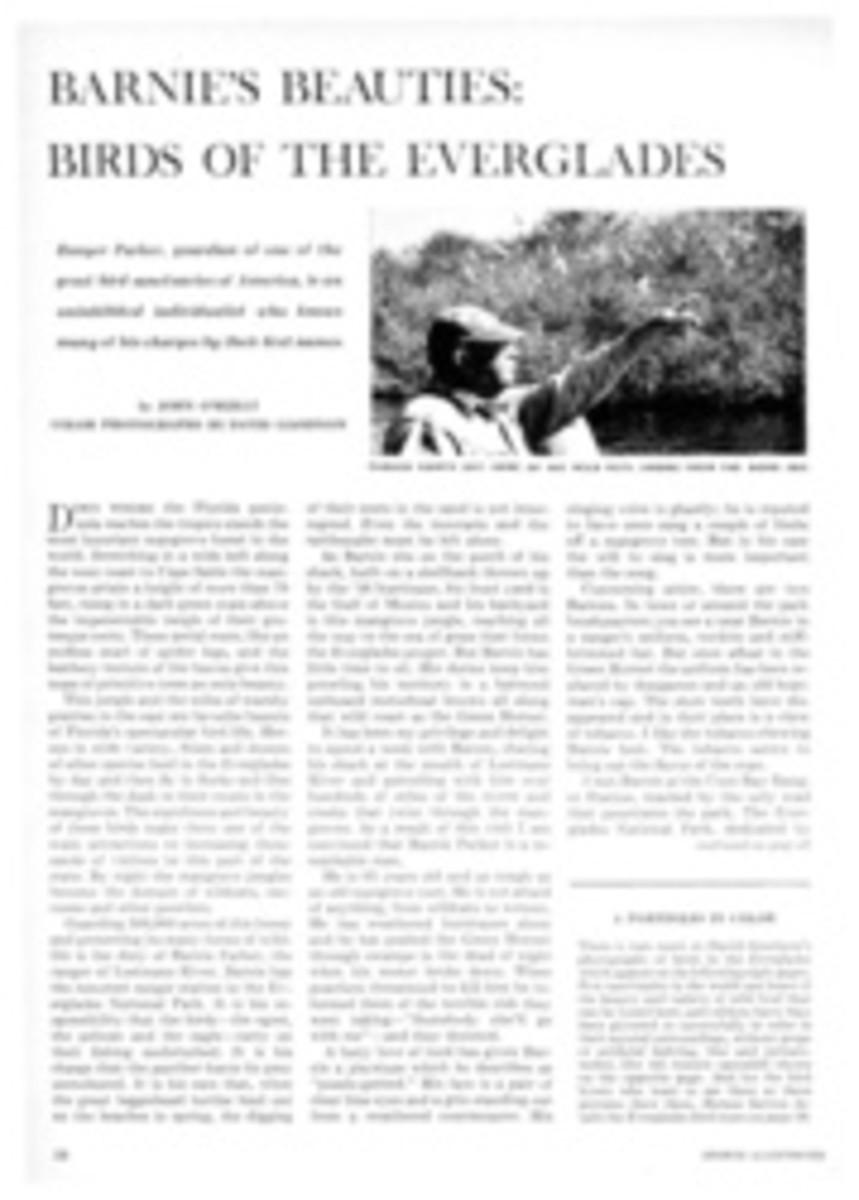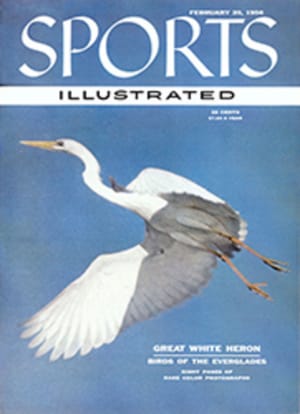
EVERGLADES TOURS
With a fleet of station wagons and three powerboats, the National Audubon Society is operating five different tours which probe the flatlands, the marshlands and the waterways of south Florida in search of many of the birds shown in David Goodnow's striking photographs on the previous pages. Most Audubon tours cost $25 for two-day trips, just over half that for one-day trips. Meals and lodging are extra.
One may, for example, in the term of one long day, depart Miami by Audubon station wagon, a uniformed guide at the wheel, and drive south to Everglades National Park. About eight miles from Homestead, along Route 27, the naturalists have built a boardwalk, known as Anhinga Trail, which stretches over a slough—a marshland of water, lily pads and birds. Purple gallinules, American egrets and snowy egrets, Louisiana herons and great blue herons stalk the slough, and the snakelike heads of the anhingas ripple the water there. Alligators lie in the solarium of the shore, disturbing their siesta only to make lunch of a garfish which is sometimes uncautious enough to leap with foolhardy exhilaration through the sunlit Florida air.
In the afternoon the station wagon rolls south to Tavernier below Key Largo, where the society's 30-foot cruiser is based. With Audubon Guide Ed Rowell at the helm and Bill Jerr on the glasses, the other day, we skimmed out into Florida Bay, a great sun washed catch basin of islands, sand bars and birds pinched between the southern tip of Florida and the string of keys. Bill Jerr was on the glasses when a lady watcher said to him, "What's that, Bill?"
"That's a box."
"No, I mean in front."
"Oh, wait a minute, wait a minute.... There's a reddish egret for you."
Every glass on the boat was turned on the egret now. He paraded like a guard at Buckingham Palace.
"There's my reddish egret," a lady said, with the satisfaction of a matron whose husband has at last come up with the mink. "I was dying to get a reddish egret."
We crossed a shallow channel, which the Audubon navigators had gouged with their ships last year, and floated into a soft milky green pond ringed by a circle of mangrove keys. Young spoonbills, not yet pink, were white splotches in the green bush. Their bright pink elders were soaring in circles round the key. A snowy egret glided overhead, with a little blue heron as his wingman, and a fat pelican sailed a small lagoon like a sightseeing boat steaming around Manhattan.
A TWO-DAY TOUR
The two-day tours include the Florida Bay excursion and begin and end in Tavernier. By far the easiest arrangement for those coming south by train or plane is to arrange with Couture Motors of Miami to have a car available at the airport or depot. You can drive it yourself the 65 miles to the Key Haven Motel at Tavernier, the Audubon base. Parking facilities are available at the motel for your car while you ride the station wagon, the first day, over the Overseas Highway to Sugarloaf Key. From there the twin 20-foot cruisers sail out into the spits and sand bars in search of the W√ºrdemann, the strange bird whose true origin is unknown. On the day I took the trip we were 3½ minutes out of the dock when we had one spotted—an extraordinary type with a body resembling that of a great blue heron and the pure white head and crest of a white heron. Ornithologists are still not sure whether the W√ºrdemann is a hybrid or a product of recessive genes in great white herons. A mission from Harvard has been down on the Keys trying to figure it out.
Birds of the northern Everglades and those that live on the fringes of Kissimmee Prairie can be seen on Audubon's overland safaris along the southern shores of Lake Okeechobee. A two-day excursion, it can be picked up in West Palm Beach or in Fort Lauderdale. The Palm Beach trips are conducted by Miss Ann LaBastille, who is 22, a 1955 graduate of Cornell (majoring in wildlife management), and who is the only-woman Audubon tour leader in the country. From her long blonde tresses, her white teeth and her handsome features, the most myopic bird watcher would have no trouble identifying her as a smooth-skinned, yellow-crowned campus beauty. However, Miss LaBastille, who was a Conover model at 14, not only identifies birds while driving relentlessly across roadless flatlands but also changes tires, climbs trees to capture botanical specimens, wears sun-tan shirt and trousers and packs a machete.
THE SWEETEST AND THE FINEST
Her trip, which I joined in West Palm Beach, travels via Belle Glade, Bean City and Bare Beach to Clewiston, a tiny town built around the United States Sugar Company's installations and known in an exquisite domino of double-entendre as America's Sweetest Town. Overnight headquarters are in the air-conditioned Clewiston Inn, built by the sugar people and known in an apt bit of single entendre as the Finest Small Hotel South. Aside from the Audubon tours, the Clewiston Inn is also a center for sportsmen who fish Lake Okeechobee for largemouth bass, and hunt in the fall for things like Florida mallard and wild turkey.
Miss LaBastille's thrice-weekly forays (and the Fort Lauderdale-based tour as well) usually produce the strange cattle egret, which feeds on insects turned up by cows' hoofs. We found coots, white egrets, red-shouldered hawks and mourning doves; rib-lean cows and great American egrets which share the drinking water of Fisheating Creek, where the fish-eating Calusa Indians lived before the Seminoles came down from the north; and, up in a live oak tree, a Carolina silk spider was trapping bugs in his four-inch net, busier than a shortstop behind a tiring pitcher.
Before heading back to West Palm Beach on the second day, our little group stopped for a last picnic in a cypress grove at the edge of Fisheating Creek. Drowsing on the grass we could see the soft blue winter's sky through the lace of Spanish moss that was stitched among the tree tops. And the cypress glens were green with the shoots of new iris soon to turn purple with the rage of spring.

